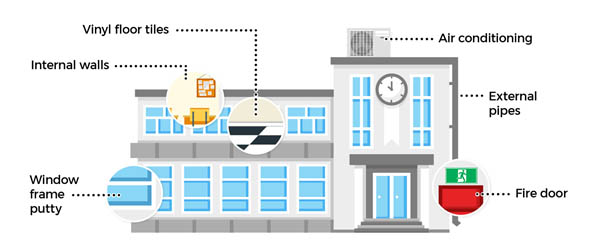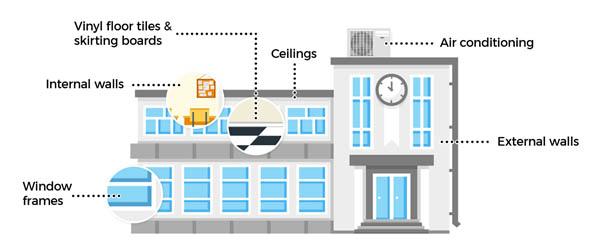Overview
The High School of Melba Copland was built in 1976, and the College in 1978. It was an era when asbestos and lead paint were widely used in the building industry.
While both these materials are present in our school we know where these materials exist, or are likely to exist, we monitor the locations regularly and we have a management strategy in place to keep our school community safe. Detailed reports are kept at the front office in a Hazardous Materials Register which you are welcome to view.
The diagram below indicates where some of these materials are located in the High School.

On the College campus, hazardous materials are found in the following locations:

Explanatory Notes
- Window frames & putty – some internal frames may be moulded asbestos, painted with lead paint; putty may have bonded asbestos fibres
- Walls – internal/external walls may bonded asbestos sheets (also known as fibro) and may be painted in lead paint
- Ceilings – may be bonded asbestos sheets painted in lead paint
- Skirting boards – may be painted with lead paint
- Fire door – core of asbestos and may be painted with lead paint
- Vinyl floor tiles – may be bonded asbestos fibres in glue, underlay and tiles
- Heating, cooling and ventilation system – lead dust in ducts. Testing shows classrooms serviced by these ducts are safe due to daily cleaning
At Our School
Lead | Asbestos | Other materials |
|---|---|---|
When our school was built Australian law allowed paint to contain up to 1% lead. All paint used before 1997 is now considered to be lead paint and is managed accordingly. That means that many surfaces in the school have been painted with lead paint. As long as the paint is in good condition it is not a risk to students and staff. The ACT government has lead management strategies which are in line with international best practice and you learn more by watching the videos below. The lead paint at our school has been assessed, sampled and tested as shown in the Lead Paint Assessments in our Hazardous Materials Registers. Each campus has its own Register, which is available for viewing at the front office of each campus. | Asbestos was widely used when our school was built because it is fire resistant, provides good insulation and is durable. There are several examples of asbestos containing materials at both the High School and College. At the High School there are asbestos vinyl floor tiles, asbestos in the core of fire doors and in the putty around window frames. At the College there are moulded asbestos window architraves, external façade sheets, internal walls and ceilings and vinyl floor tiles. Information about these materials can be found in the Asbestos Survey and Management Plan. There is a Plan for each campus, located in the Hazardous Materials Register. | Both campuses of our school have synthetic mineral fibre (SMF) yellow batts in the ceiling for insulation, and some SMF lagging around duct work and hot water pipes. Licensed environmental assessors say that during routine occupation of a building levels of airborne SMF fibres would be insignificant. The College has an underground tank which was used to store fuel for heating the school. The tank has been decommissioned and sealed. One air conditioning unit in the High School is suspected of having a refrigerant called R22 which is an ozone depleting substance (ODS). Licensed assessors say with proper management of those units, there is a relatively low risk of ODSs leaking into the environment. Mould is a type of fungus that grows best in damp and poorly ventilated areas. To reproduce, mould produces tiny particles called spores. These spores travel easily through the air. Exposure to some moulds can trigger nasal congestion, sneezing, cough, wheeze, respiratory infections and worsen asthma and allergic conditions. Contact with mould can also irritate eyes and skin. People who are more likely to experience these symptoms include those with weakened immune systems, allergies, severe asthma or lung diseases. There is no exposure limit or health guideline value for exposure to mould. |
Upcoming Works
Scheduled work to remediate or remove hazardous materials is often conducted during student free periods (school holidays). Individual schools are notified prior to works occurring and scheduled upcoming works are listed here.
Further information on hazardous materials can be found on the Education Directorate website.
The Education Directorate is committed to transparency about how it manages hazardous materials. Hazardous Materials Register are developed for all schools with known hazardous materials. The Register is a collection of reports about what hazardous materials exist in the school, where they are, and how they are being managed. It is used as a guide to inform maintenance and upgrade works.
Hazardous Materials Registers are public documents and can be located at the front office of each school.
External Hirers
The community is encouraged to hire our facilities. Here is a fact sheet for those renting our spaces about how hazardous materials are managed in our school.
